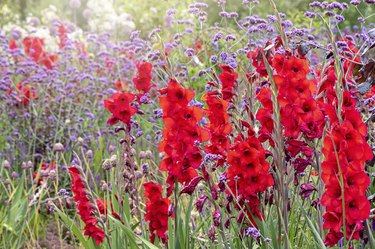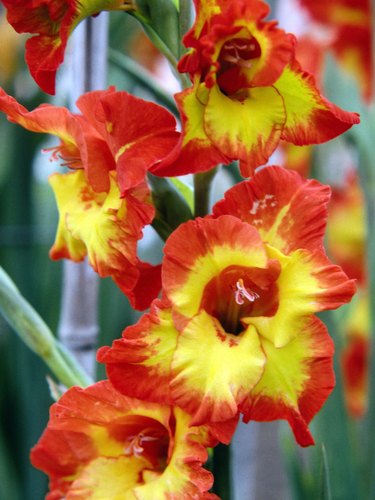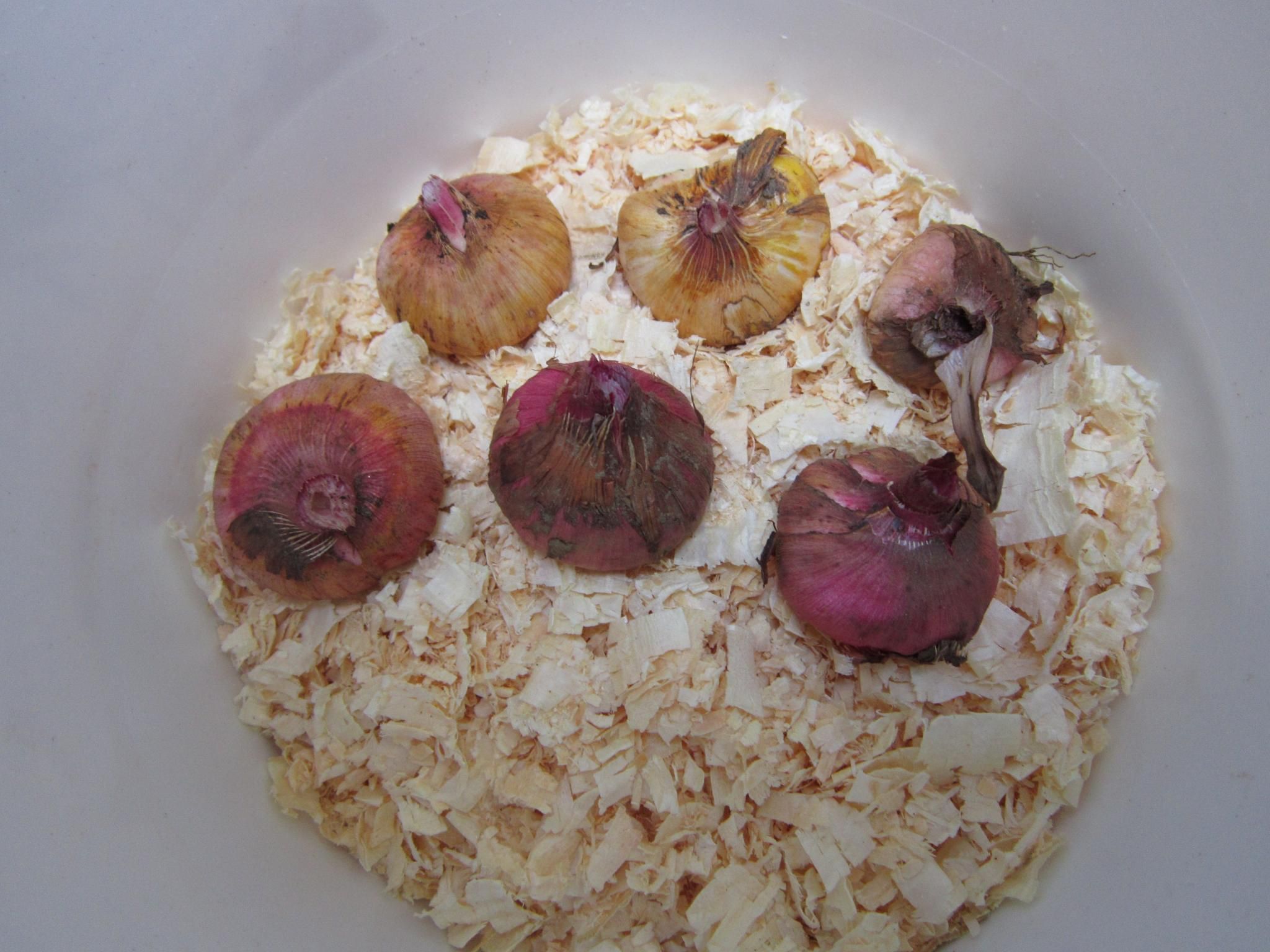A lot of gardeners are talking about how hardy gladiolus plants are for winter. Fans just call them “glads.” The traditional wisdom is that you must dig up the corms of glads (Gladiolus spp. ) in the fall and put them away for the winter if you live in a zone below USDA Plant Hardiness Zone 8.
The corms of gladiolus plants should be dug up and stored over the winter to protect them. They are not usually cold-hardy enough to survive a hard freeze, which is 28 degrees Fahrenheit or less. Some gardeners have experience with glads that have come back after hard freezes, however.
Gladiolus, also known as gladiolas or glads, are popular summer-blooming bulbs grown for their showy, magnificent flower spikes. They add vibrant colors like red, yellow, orange, pink, white and purple to the garden. Gladiolus bulbs, called corms, are not cold hardy and need to be dug up each fall in regions with freezing winters. Knowing when to dig up the corms is key to successfully overwintering them for the next year.
Why Dig Up Gladiolus Corms
Gladiolus corms originate from mostly warm climates like Africa, Asia and the Mediterranean. They go dormant in fall and cannot survive hard freezes and frost. If left in the ground over winter in zones with freezing temps, the corms will rot and die Digging them up after the foliage dies back allows them to be stored indoors in a cool place until spring. This preserves them in a dormant state until the danger of frost has passed. Then they can be replanted again for another year of beautiful blooms.
When to Dig Up Gladiolus
Timing is important when digging gladiolus bulbs. It’s best to allow the foliage to die back naturally after the flowers are done blooming. The leaves need time to photosynthesize and transfer nutrients back into the corms. This helps ensure large, healthy corms for next year.
Here are some guidelines on when to dig gladiolus corms:
-
Wait until at least 6-8 weeks after blooming – Allow adequate time for foliage to yellow and die back after flowers are spent
-
After first frost – Dig corms after foliage has been killed by a hard frost.
-
When foliage is yellow/brown – Corms can be dug once leaves turn yellow or brown and die back
-
Before ground freezes – Dig before ground becomes frozen in late fall or early winter.
-
October/November – Ideal months for digging in most zones are October and November.
Pay attention to weather forecasts. An early frost may mean digging earlier in fall. It’s better to dig a little early before ground freezes than too late after corms have been damaged.
How to Dig and Store Gladiolus Corms
Follow these steps for proper gladiolus corm harvesting and storage:
Digging
-
Use a garden fork or spade, inserting it 6-8 inches away from the corms to avoid spearing them.
-
Gently lift plants out of ground and shake off excess soil. Don’t wash corms yet.
-
Optional: Cut off faded flowers and dead foliage, leaving 1-2 inches of stem.
Curing
-
Place corms in a single layer on newspaper or screens. Allow to dry for 2-3 days in a warm, well-ventilated area around 70-80°F.
-
Curing helps seal wounds and prevent disease. Drying stops growth and allows old corms and roots to separate from new.
Cleaning and Sorting
-
Use a brush to clean off any remaining dried soil.
-
Carefully separate new corms from old. Discard diseased or damaged ones.
-
Keep large, healthy new corms for replanting. Set aside smaller cormels for growing on.
Storing
-
Place cleaned corms in paper or mesh bags. Or pack in trays or boxes with peat moss/vermiculite.
-
Store in a cool, dark place around 40-45°F. A basement, garage or refrigerator works well.
-
Check periodically for mold or rotting bulbs which need removal.
-
Keep corms dry but not completely shriveled. Occasionally air out bags.
Proper gladiolus winter care will reward you with vibrant, thriving plants for years to come. Just be sure to time corm digging and storage correctly. With a little practice, you’ll become adept at harvesting gladiolus bulbs. The joy of their renewed blooms next season makes the extra effort worthwhile!
How to Store Glads Over the Winter
After your gladiolus has bloomed, dont down off the stalk. Before you dig up your glads, you should make sure that the leaves have died—not just wilted, but completely dried out. Until then, the foliage is still feeding the bulb nutrients. This is usually about six weeks after bloom in midfall. Using a spade, dig up the entire plant, taking care not to bruise the corm. At this point, you can cut off the withered stalk about 1 to 2 inches above the corm.



Dry the corms in a shady, warm location for about two weeks until completely dry. Now is the time to take off any small “cormels” that may be growing on the mother corm. You can save these and plant them again if you want to. These will look just like the mother plant, so it may be worth the wait. It will take two or three years before they bloom.
At this point, you can remove and discard the oldest corm, which will still be connected to the bottom of the new corm. Retain the husks and then dust the corms with a fungicide by placing the corms in a paper bag with the fungicide and shaking. Store the corms in a dry location where they wont touch each other, such as in newspaper or sawdust. If you have a basement, thats perfect, as you want a temperature of about 35 to 45 degrees. Dont let the corms freeze.
In the spring, replant the corms a couple of weeks after your locations last frost. They should bloom by midsummer.
To Dig or Not to Dig
Glads grow best in USDA hardiness zones 7 through 10, where their corms can stay in the ground all year. Some experts say that digging them up and storing them over the winter in these areas is still the best way to keep the corms healthy and get the best blooms in the future. This can also help keep diseases from spreading from year to year and beds from being too crowded.



Video of the Day
Many sources, though, say that the corms should only be dug up in zones 7 and colder. However, some gardeners say that their glads have survived the winter in zones 5 or even 3. Usually, they discover this by accident, having failed to dig up their corms in the fall. Over time, even if the flowers come back and bloom, fewer and fewer corms will survive and sprout. This is called natural attrition. Nonetheless, it may be possible to protect them and coddle them in the ground over the winter.
If you wish to try keeping your glad corms in the ground, follow a few best-practice growing strategies. First, be sure your gladioli are situated in a full-sun location in sandy or at least well-drained soil. Plant them extra deep — 6 inches instead of the normally recommended 2 to 4 inches. Finally, cover them with a thick layer of mulch, such as straw, grass clippings, or fallen leaves. If it snows in your area, thats fine too; the snow will provide additional protection from freezing wind.
Some nurseries specialize in hybridizing smaller, more cold-hardy gladiolus varieties, advertised to be hardy down to zone 5.
Digging and Storing Gladiolus Bulbs
FAQ
How do you store gladiolus bulbs for the winter?
Can you leave gladiolus bulbs in the ground all year?
What happens if you don’t dig up gladiolus bulbs?
When should I dig up gladiolus corms?
In colder regions (Zone 7 or colder), dig up gladioli corms once the foliage has faded after the first fall frost. A light frost will kill the foliage but not the rest of the plant. Be sure to dig up the gladiolus corms before a hard freeze (28°F), or the plants could be fatally damaged.
When to plant Gladiolus bulbs?
Gladiolus bulbs are planted in spring after the last possible frost in your area. The soil should be around 55°F. If you plant when the soil is too cold, the bulbs may rot before they have a chance to sprout. Before planting, inspect the bulbs you have to ensure they look healthy and are free of disease or pests.
Do Gladiolus bulbs need to be stored in winter?
In order to enjoy the beauty of gladiolus flowers year after year, most gardeners must store their gladiolus corms (sometimes also referred to as gladiolas bulbs) in the winter. Gladiolus bulbs, or corms, aren’t hardy through frozen winter months, so you must dig them up and store them until spring if you want to grow them again the next year.
How do you dig up a Gladiolus?
Once the foliage is brown, you can start gently digging up the gladiolas corms from the soil. Dig the corms of gladiolus using a garden fork or spade, digging far enough away so that you don’t touch the corm. Pull the plant by its dried leaves and shake it gently to remove any loose dirt.
- The Ultimate Guide to Growing Strawberries in Raised Beds - August 8, 2025
- No-Dig Garden Beds: The Easiest Way to Grow a Beautiful Garden - August 6, 2025
- How to Protect and Preserve Wood for Raised Garden Beds - August 6, 2025

